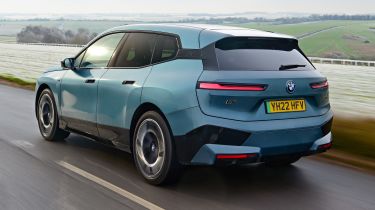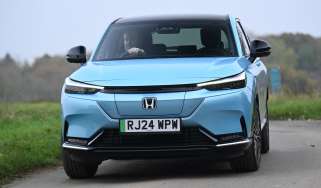BMW iX review - Range, charging and running costs
If you can afford to buy and insure it, the iX will reward you with fabulously low running costs

Depending on which model you go for, the iX features either a 71kWh or much larger 105.2kWh battery. The entry-level xDrive40 uses the smaller unit and, according to BMW, will cover 264 miles on a single charge. When we drove this particular model, it returned 3.0 miles per kilowatt-hour, which equates to a real-world range of around 230 miles, although we’d expect this to improve slightly in warmer weather.
Upgrading to the xDrive50 gets you the larger battery and boosts the luxury electric SUV's range up to 380 miles. We drove the iX xDrive50 during a typical British winter and based on our experience, it should offer not far shy of 300 miles in cooler conditions. Again though, like all electric cars, the range should improve in the warmer months.
The M60 gets the same 105.2kWh battery pack as the xDrive50, but with a reduced range of 349 miles as a result of its performance upgrades. That figure may be possible in Efficiency mode with careful driving and not in sub-zero temperatures like those we encountered during during our testing, however we saw the M60 achieve an extremely poor 1.8mi/kWh when we drove it; enough for a real-world range of just 189 miles.
Used - available now
In terms of charging, the xDrive40 can hit 150kW while the xDrive50 and M60 both have a maximum charging speed of 200kW. Regardless of which model you go for, a 10 to 80 per cent top-up will take a little over half an hour from a suitably fast ultra-rapid charger. Fully recharging the xDrive40’s 71kWh battery using a standard 7.4kW home wallbox will require 11 and a half hours, but that extends to nearly 17 hours if you go for the xDrive50 or M60.
Insurance groups
The iX is not going to be cheap to insure, as even the entry xDrive40 model sits in group 47 on the 1 to 50 scale. The xDrive50 and M60 are in group 50, although anyone spending in excess of £100k on their car is unlikely to be too concerned about pricey premiums.
In comparison, the Audi Q8 e-tron and Mercedes EQC are broadly similar, with models in groups 44 to 50.
Check any car's MoT history in a few easy clicks with our MoT checker tool...
Depreciation
Luxury all-electric cars generally maintain solid residual values, although of course you’ll be paying out a sizable sum to buy one in the first place. The iX xDrive40 is the cheapest model in the range and also the slowest depreciator, holding onto around 59 per cent of its original list price over a typical three-year/36,000-mile ownership period. While this sounds a decent figure, it actually means the iX is expected to lose almost £30,000 of its original value after 36 months.
The more expensive xDrive50, in the popular M Sport trim, is now predicted to hold onto an average of 52 per cent of its value over the same three year period, which equates to a loss of around £49,000 compared to its original list price. Of course, most cars will almost certainly be on some form of lease agreement and not bought outright, but it’s worth bearing these depreciation costs in mind. The M60 is the fastest depreciating model in the range and is expected to hold onto just 47 per cent of its original value after the same ownership period.
To get an accurate valuation on a specific model check out our valuation tool...
















